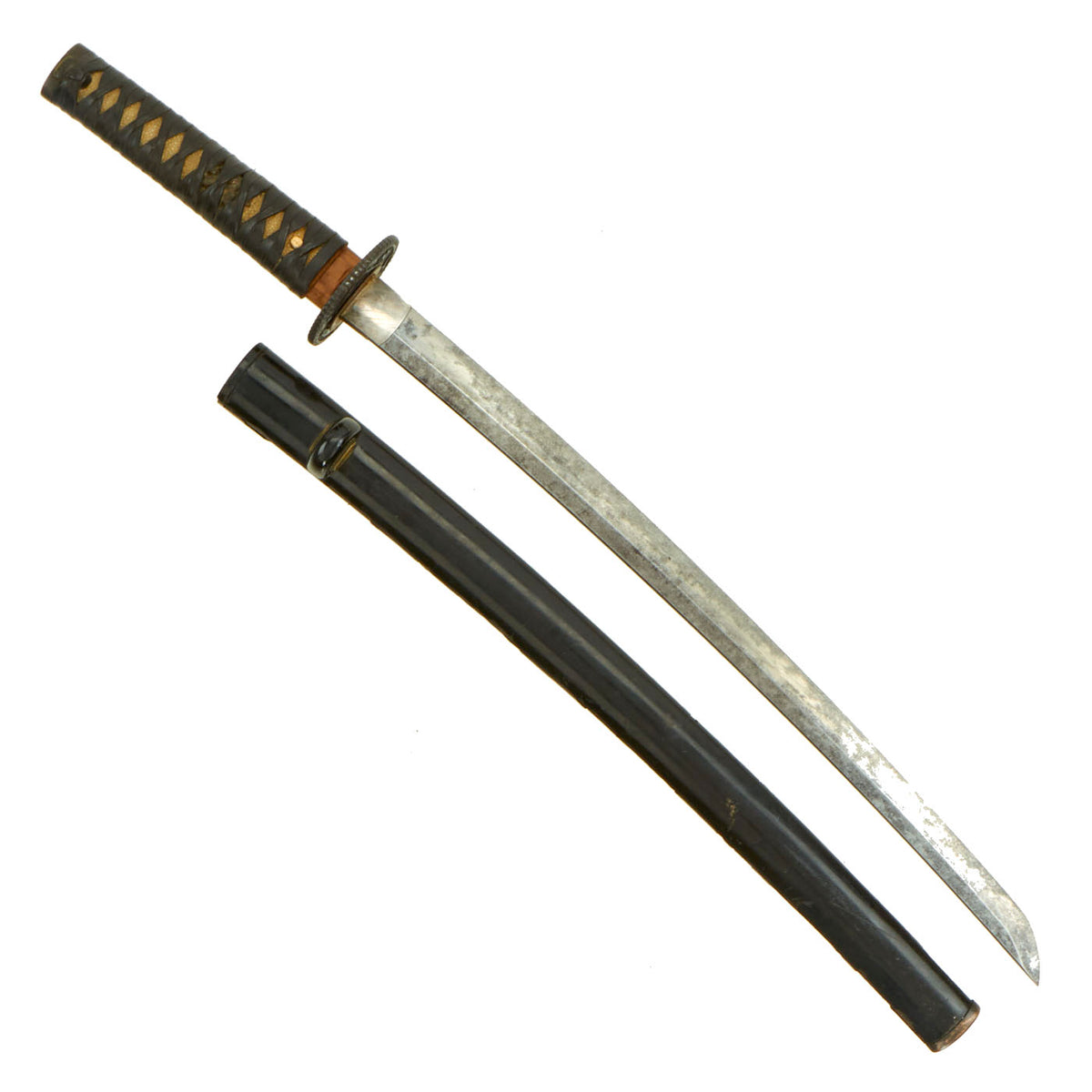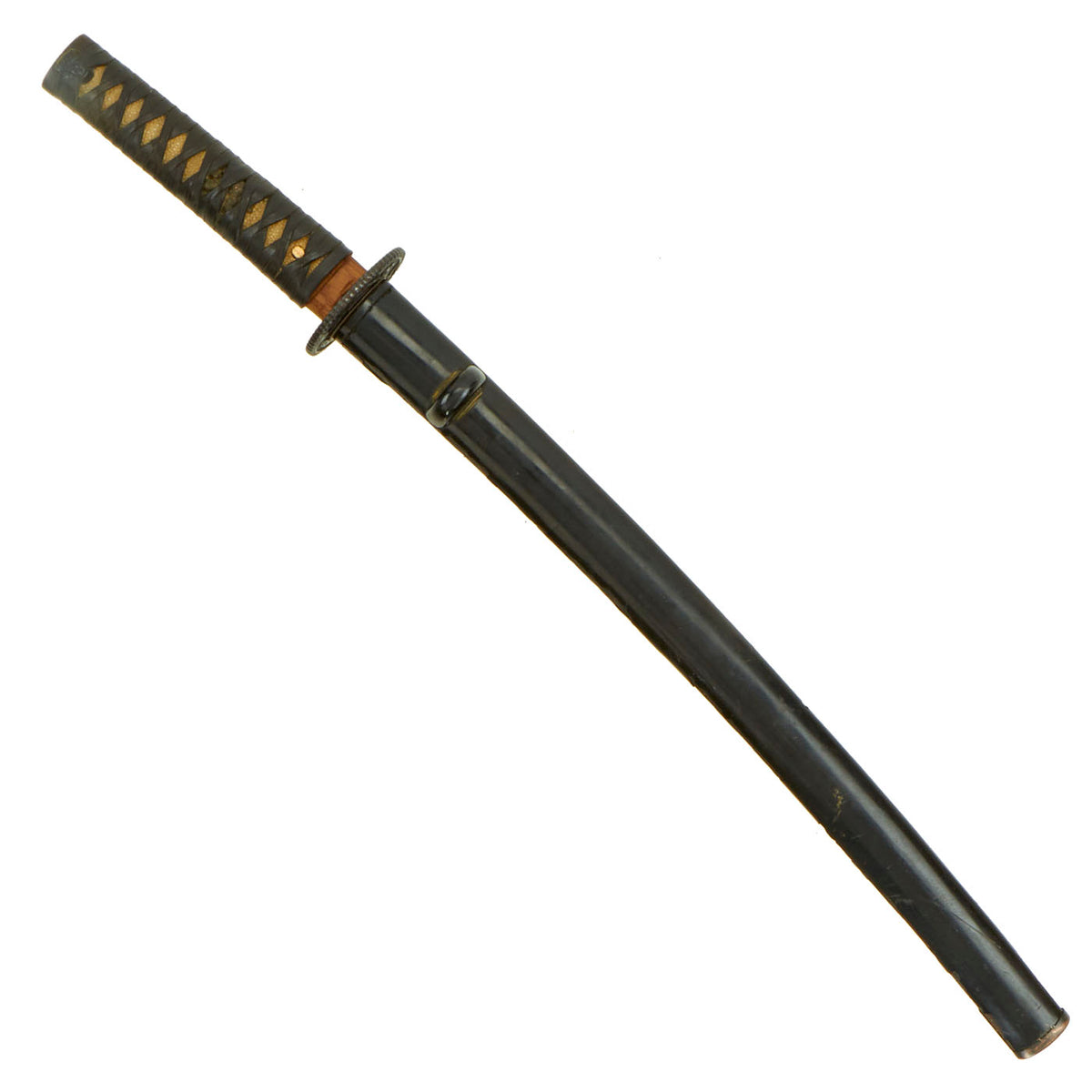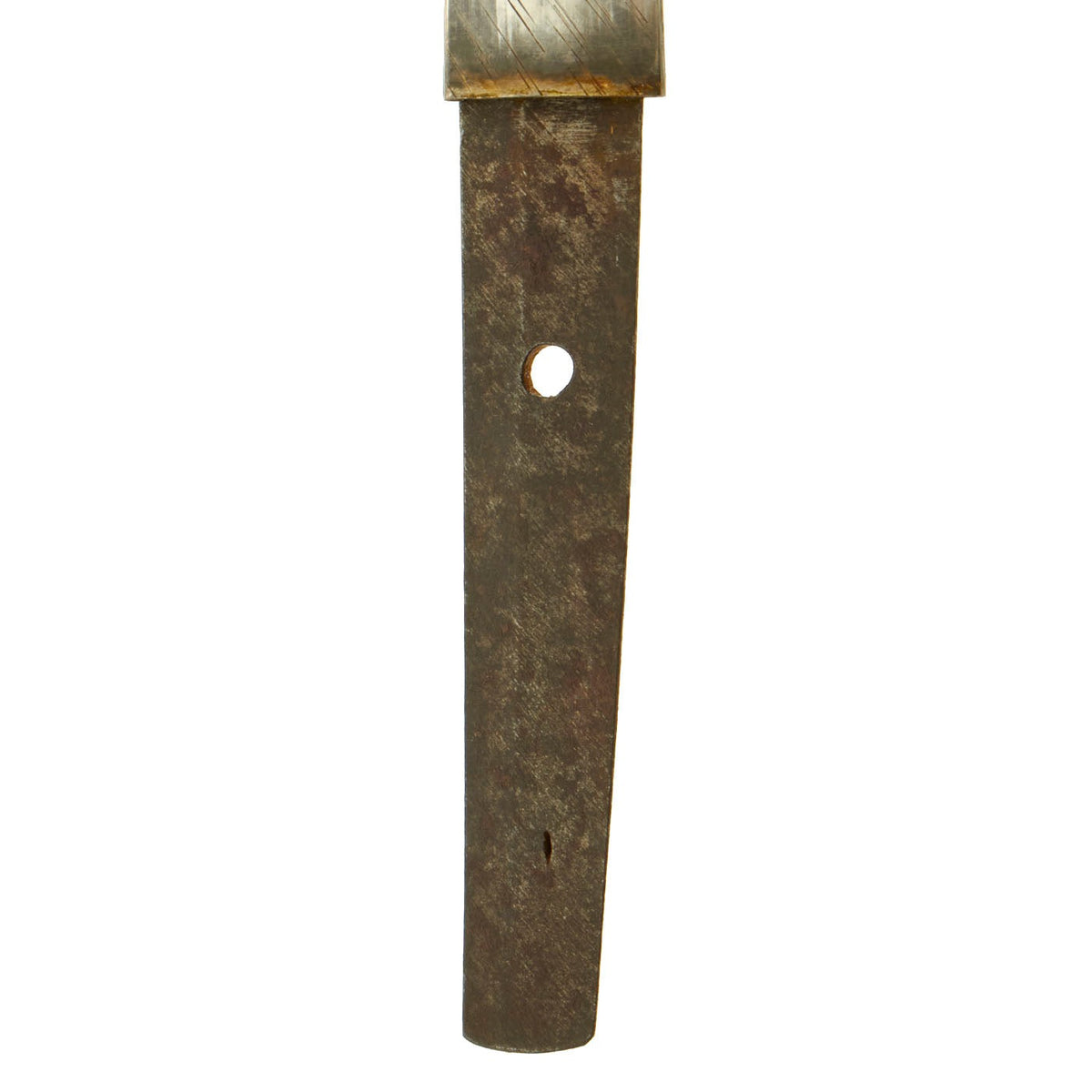Original 18th Century Japanese Handmade Wakizashi Short Sword with Leather Wrapped Grip & Lacquered Scabbard Original Items
$ 1.595,00 $ 398,75
Original Item: Only One Available. Wakizashi (脇差 “side inserted / companion sword”) is a general term for a sword with an edge between one and two shaku long (30 cm and 60 cm), predominantly made after 1600. Generally it is the short blade that accompanies a katana in the traditional samurai daisho pairing of swords, but may be worn by classes other than the samurai as a single blade, also worn edge up as the katana.
This example dates from the later Edo period (江戸時代, Edo jidai) or Tokugawa period (徳川時代, Tokugawa jidai) of Japanese history. This is the period between 1603 and 1867, when Japan was under the rule of the Tokugawa shogunate and the country’s 300 regional daimyo. It is around the middle of the blade length range, and has a “Shinogi Zukuri” shape, the most common shape used, and the standard for the longer Katana.
This example has most likely been remounted several times, as was common for Japanese blades. This has made the file marks (yasurimi) on the tang faint, and given it a lovely patina. As there is no maker name on the tang, this blade is considered 無名 (mumei), or “anonymous”.
The blade has the following period correct features:
– Folded steel blade (fold lines are evident on the spine and body of the blade)
– hole (mekugi-ana) in the tang is punched and not drilled
– blade has a temper line (hamon), which is visible in various areas.
– Blade wounds (kizu) or lamination artifacts are present on the blade. Both ware (lamination lines) and fukure (carbon pits) are visible.
The blade of this example is 18 3/4 inches long, and the polish on the blade is unfortunately degraded, with many areas of light surface staining, some of which has been cleaned off. This has made seeing aspects of the blade very difficult, and it has definitely been some time since the last time it was fully polished. The blade is still quite sharp, though there are some chips in the edge. Overall length of this wakizashi is 26 1/2 inches.
The tang (nakago) is of the futsu 普通 (regular) style, with a Kuri-jiri (symmetrically rounded) nakago-jiri (tang tip). There are blade wounds including ware (lamination splits) and fukure (Carbon pits). The hamon (temper line) is still faintly visible in one areas of the blade where there is no staining, and it is a very active CHOJI (clover treeflower), with some TOURAN (billowing) aspects. There look to be some UCHINOKE crescent shaped lines of NIOI cloudiness above the temper line. It’s a shame that it is not in better polish. The boshi and yokote are unfortunately not visible at all. The sword has a very nice silver Habaki (blade collar) with “rain” engraving, which is typical of the Edo period.
The tsuba (cross guard) is made of iron and is of the Maru Gata (round) shape, embossed with a dragon on either side, which has some gold highlighted. completely unadorned. There are two Hitsu-Ana accessory cutouts in the tsuba for the kogai (hair ornament) and kogatana (companion knife”, though there are none included with the wakizashi. There are two seppa (spacers) around the tsuba.
The fuchi (collar) for the tsuka (handle) is missing, and there is a simple iron Kashira (End Cap) on the bottom. There are two bronze menuki grip ornaments present, which look to be dogs. The stingray (Sa-Me) grip is in very good condition, and the grip wrapping (Ito) looks to be of finished leather, something we have not seen before. It shows light wear, and is in overall very good condition.
The sword comes in a a well fitting gloss black lacquer wooden scabbard (saya), which has a cutout for a kogatana knife, which is unfortunately absent. The scabbard is in good condition, and definitely looks to be of great age. There is splitting along the seams, and the black lacquer has chipped away in those areas. It has a kurikata (knob) where the sageo (sword cord) would be attached, which has an internal shitodome collar fitting.
A nice Edo Period O-wakizashi, complete with scabbard and ready to display!
Specifications:
Blade Length: 18 3/4“
Blade Shape: Shinogi Zukuri
Overall length: 26 1/2“
Scabbard Length: 19 1/2“
It has been over one thousand years ago that the art of making swords appeared in Japan. The swordsmiths of the time may not have known it but they were creating a legendary sword. The Samurai sword has seen combat in many battlefields. From the early days of the Samurai warrior to the fierce battles in the South Pacific during WWII.
Each hand-made Japanese blade (日本刀 – Nihonto) is unique because it is forged from multiple pieces of folded steel stock. A tremendous amount of work is dedicated to creating these pieces. They were an instrument of war as much as a beautiful artifact to adorn a room.
The traditional Japanese blade and mountings have grown to be one of the most highly desired military antiques.
Fast Shipping with Professional Packaging
Thanks to our longstanding association with UPS FedEx DHL, and other major international carriers, we are able to provide a range of shipping options. Our warehouse staff is expertly trained and will wrap your products according to our exact and precise specifications. Prior to shipping, your goods will be thoroughly examined and securely secured. We ship to thousands clients each day across multiple countries. This shows how we're dedicated to be the largest retailer on the internet. Warehouses and distribution centres can be located throughout Europe as well as the USA.
Note: Orders with more than one item will be assigned a processing date depending on the item.
Before shipping before shipping, we'll conduct a thorough inspection of the items you have ordered. Today, the majority of orders will be delivered within 48 hours. The delivery time will be between 3-7 days.
Returns
The stock is dynamic and we cannot completely manage it because multiple stakeholders are involved, including our factory and warehouse. So the actual stock may alter at any time. It's possible that you may not receive your order once the order has been made.
Our policy is valid for a period of 30 days. If you don't receive the product within 30 days, we are not able to issue a refund or an exchange.
You can only return an item if it is unused and in the same state as the day you received it. You must have the item in its original packaging.
Related products
Uncategorized
Uncategorized
Uncategorized
Uncategorized
Uncategorized
Angolan Rebel 1970s era 60mm Inert Display Mortar from Angolan Civil War Original Items
Uncategorized
Uncategorized
Uncategorized
Uncategorized
Uncategorized
Uncategorized
Uncategorized
Uncategorized
Uncategorized
Armoured Fighting Vehicles of the World: AFVs of World War One (Hardcover Book) New Made Items
Uncategorized
Uncategorized
Band of Brothers ORIGINAL GERMAN WWII Le. F.H. 18 10.5cm ARTILLERY PIECE Original Items
Uncategorized
Uncategorized
Uncategorized












































































